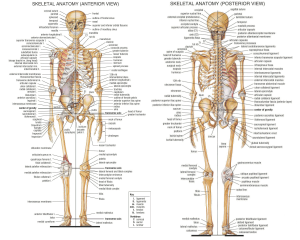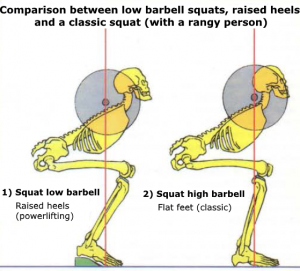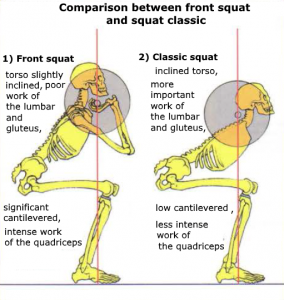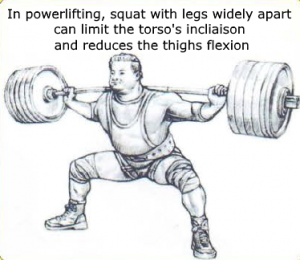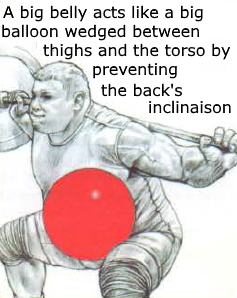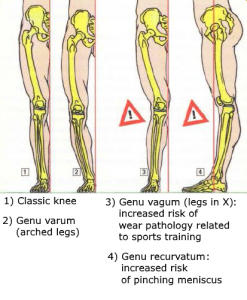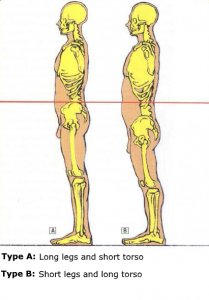This is The Stephane Andre and today I’m talking about adapt your training to your morphology. I read Frederic Delavier’s book « Strength Training Anatomy » and I learned good stuff. This is the part two.
If you didn’t read Part 1, click here.
Legs
Improve your squat position
There is a tip to reduce the lower back’s effort and limit the hamstrings tension. Put the barbell on posterior deltoids like powerlifters.
This method increases the power of lifting from the back. This allows you to lift heavier weights. Use weightlifting shoes (solid raised heel) or a wedge under the heel to not have your buttocks too back. This allows you to have a greater amplitude with the thighs flexion.
You feel better your quadriceps, because you limit the torso’s tilt. The low barbell and raised heel combination allow you to lift heavier weights. It’s useful for people are tall or with stiff ankles to correct their squat’s execution.
Front squat to target quadriceps
Front squat limits the torso’s tilt. Having the barbell at the front reduces the work of the lower back. It also decreases the tension of the hamstrings and adductor muscles. But, it forces quadriceps to make more effort to extent the thigh.
Which means it’s the perfect squat for thighs. Unfortunately, you can’t lift heavyweights like the classic squat. It’s recommended to do it with heels elevated for better stability.
For tall people, front squat is very hard to do. Their torso is more inclined, which make it more difficult to hold the barbell.
Spread the legs to less incline the torso
There is a squat’s technique to limit the torso’s inclination. This involves spreading the legs with the feet outward. Some powerlifters do this technique with the legs almost wide apart. With the legs apart, this limits the legs flexion.
To do squat with the legs apart, it’s necessary to be flexible of hip joint and adductor muscle.
The advantage of the big belly
Having a big belly for squat and deadlift allow to compress it against the thighs. This helps to limit the inclination of the torso and the back’s rounding. This has the effect of protecting the lower back and limiting the risk of herniated disc.
This is the reason you can see a lot of powerlifter/weightlifter’s champion with a big belly. They take care to keep their belly fat with an rich diet.
Different forms of knees
It’s important to take into account the different morphologies, especially for the knees.
Arched legs (genu varum) are not more risky than normal legs.
This is two cases. People with X legs (genu varum) and people who can overly extend the thighs (genu recurvatum). It’s recommended for them to not use very heavyweigts for legs exercises.
Cases of genu valgum are often :
- People who were overweight during their youth, when their leg bones were malleable. Their legs deformed because of the overload. Now, they have this X shape.
- For women, in fact women have wider hips to have children. This influences the femur’s direction which are generally more inclined.
For people with genu valgum. If the genu valgum is to excessive, the joint would be overused. The medial collateral ligament would be extremely tense. The lateral meniscus, the articular surfaces coated with cartilage of the external condyle of the femur, and the external lateral tuberosity of the tibia would be subjected to excessive friction, which would cause pathologies of wear.
For people with genu recurvatum. These are people who are essentially very flexible named hyperlaxes or women whose muscular and ligamentous hyperlaxity is related to reproductive function.
There is something rare. Knees with genu recurvatum can sometimes have some problems like the meniscus pinching. This can happen when the knees are rapidly expanding and the meniscus haven’t had enough time to slip, or during an exercise with a heavy weight that has forced the hyperextension of the thigh.
It’s for this reason that it’s recommended to people suffering from a genu recuvatum pathological never to totally block the knees at the end of the leg’s extension for squat or leg press.
Note
For 2 people who are the same size, it’s important to consider the torso-leg ratio.
Type A :
People with proportionally long legs and a short torso will have trouble doing a proper squat without tilting their torso excessively forward.
On the other hand, the long legs and long torso facilitates the execution of the good-morning, classic deadlift and Romanian deadlift.
Type B :
People with proportionally short legs and a long torso will have the facility to squat safety without tilting their torso excessively forward. It’s for this reason that the great champions of powerlifting, squat specialist, have this type of morphology.
Share this article if you think it can help someone you know. Thank you.
-Steph
